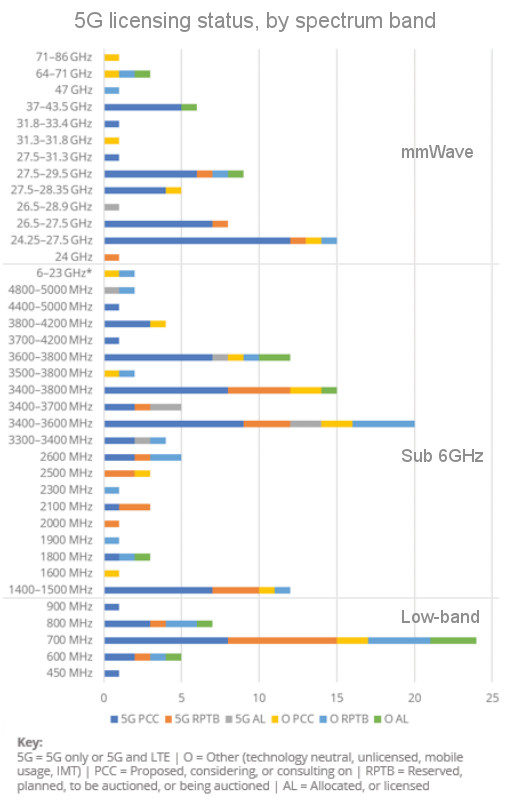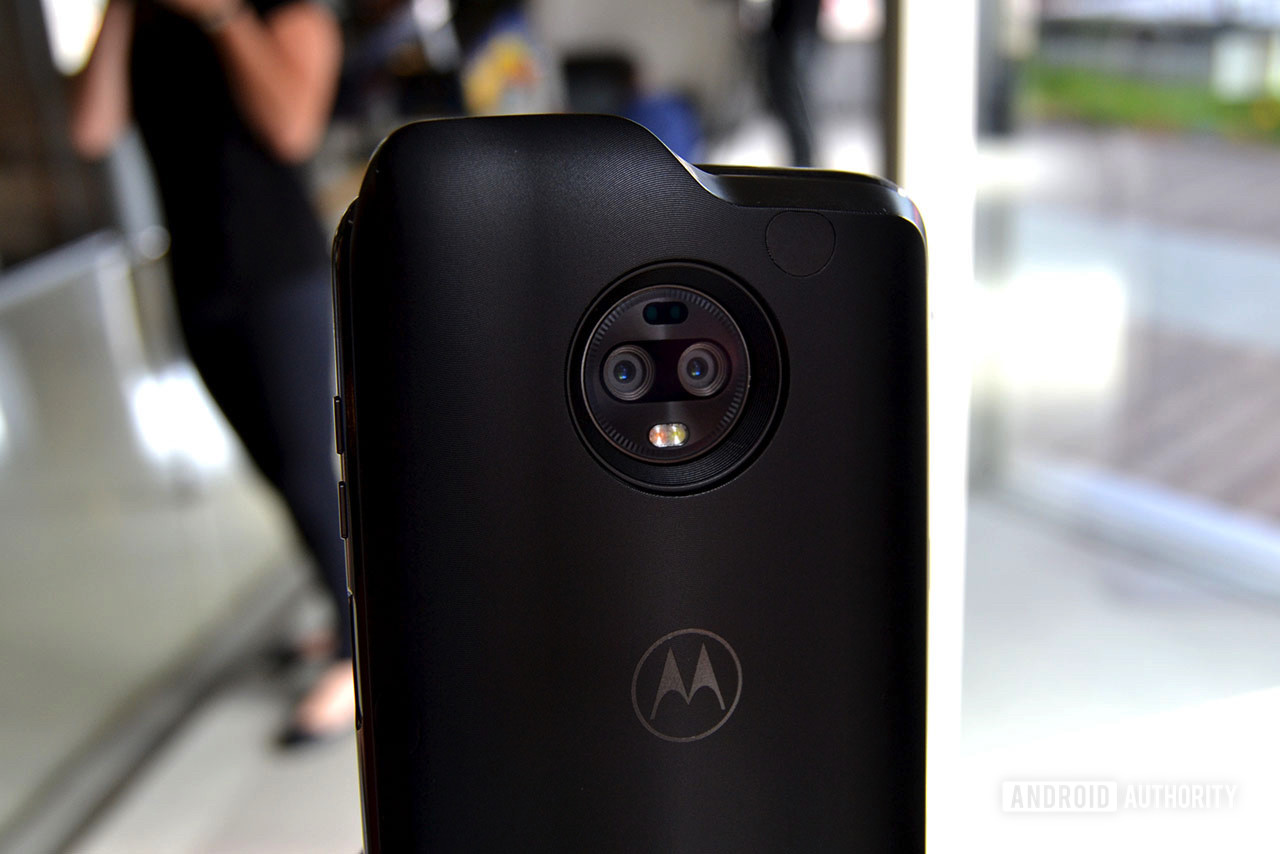 Next generation 5G networks are back in the headlines following the unveiling of the Moto Z3 5G Moto Mod. While not a standalone 5G smartphone, the Moto Mod supports 5G mmWave technology, the cornerstone technology of upcoming 5G networks according to many observers, along with sub 6GHz bands.
MmWave technology involves the use of very high-frequency radio signals used to transmit data. Typical 4G networks operate in the 2 to 8GHz spectrum, while mmWave opens up use in the 24 to 90GHz range. There’s clearly plenty of extra unused spectrum in this space to boost capacity and reach the lofty goals of 5G data speeds.
However, I think the industry is overemphasizing the importance of mmWave technology. The actual makeup of upcoming 5G networks is going to be much more diverse.
What will 5G spectrum actually look like?
The Global mobile Suppliers Association (GSA) has a new report examining real-world 5G spectrum around the globe. The data is as recent as July 2018 and covers spectrum auctions and designations from 42 national regulators. In other words, it paints a very accurate picture of the spectrum actually being set aside for 5G.
The paper delves into the specifics in each of the 42 countries, making it a worthwhile a read to see what your country is up to. I want to highlight the graph near the end, which tracks the total proposed spectrum by bands across the globe.
Next generation 5G networks are back in the headlines following the unveiling of the Moto Z3 5G Moto Mod. While not a standalone 5G smartphone, the Moto Mod supports 5G mmWave technology, the cornerstone technology of upcoming 5G networks according to many observers, along with sub 6GHz bands.
MmWave technology involves the use of very high-frequency radio signals used to transmit data. Typical 4G networks operate in the 2 to 8GHz spectrum, while mmWave opens up use in the 24 to 90GHz range. There’s clearly plenty of extra unused spectrum in this space to boost capacity and reach the lofty goals of 5G data speeds.
However, I think the industry is overemphasizing the importance of mmWave technology. The actual makeup of upcoming 5G networks is going to be much more diverse.
What will 5G spectrum actually look like?
The Global mobile Suppliers Association (GSA) has a new report examining real-world 5G spectrum around the globe. The data is as recent as July 2018 and covers spectrum auctions and designations from 42 national regulators. In other words, it paints a very accurate picture of the spectrum actually being set aside for 5G.
The paper delves into the specifics in each of the 42 countries, making it a worthwhile a read to see what your country is up to. I want to highlight the graph near the end, which tracks the total proposed spectrum by bands across the globe.
 GSA
Although the graph shows that mmWave spectrum above 24GHz will play a significant part in 5G networks, it’s certainly not the largest segment. In fact, it looks like there will be roughly as much new low-band spectrum allocated as mmWave. Furthermore, the 700MHz band is by far the largest single piece of spectrum designated for new use cases around the world.
Mid and low-band spectrum provisioning is much larger than for mmWave.
This makes sense. MmWave spectrum is limited in its applications — it only covers very short ranges and densely populated areas in need of very high capacity and is currently expensive to implement. Frequencies below 1GHz will prop up coverage over long ranges and at the cell edge (more on that in a minute).
Instead, the bulk of future 5G networks will consist of the “sub 6GHz” mid-band group, which encompasses everything between 1 and 6GHz. This is already a reasonably congested area of spectrum, as 2.4GHz and 5GHz Wi-Fi and 2.45GHz Bluetooth sit in this range, as do many 4G LTE bands. As such, much of this new spectrum will appear in the 3 to 4GHz range, sitting right in between current Wi-Fi and LTE networks to avoid congestion issues.
Of course, this data will change as network operators and regulators refine their 5G plans in the coming years.
mmWave and the trouble with 5G
The sub-6GHz spectrum’s appeal is as an ideal middle ground between existing network backbones in the 3G and 4G space which also boosts capacity just like mmWave. MmWave base stations offer ranges measured in the low hundreds of meters and are severely limited by line of sight and obstacles like walls. Sub 6GHz doesn’t suffer from these problems nearly so severely and will provide large areas of coverage in densely populated areas.
Furthermore, the market for 2.4 to 5GHz Wi-fi networking equipment is already well established and cost-effective. Scaling this up to cover larger areas for 5G networks won’t require a massive (and expensive) leap to large MIMO antenna and base station arrays like mmWave.
Low-band spectrum will be the backbone of emerging mass-IoT technologies like smart cities.
Additional low-band spectrum is particularly important to improve cell edge connectivity, both at a distance from major metropolitan and over geographically complex areas. Sub-6GHz and mmWave networks don’t work very well over long distances. You’re not going to manage your smart city traffic lights with hundreds of mmWave base stations. 700MHz bands will form the backbone of wide coverage 5G networks both in terms of geography and new connected IoT technologies.
GSA
Although the graph shows that mmWave spectrum above 24GHz will play a significant part in 5G networks, it’s certainly not the largest segment. In fact, it looks like there will be roughly as much new low-band spectrum allocated as mmWave. Furthermore, the 700MHz band is by far the largest single piece of spectrum designated for new use cases around the world.
Mid and low-band spectrum provisioning is much larger than for mmWave.
This makes sense. MmWave spectrum is limited in its applications — it only covers very short ranges and densely populated areas in need of very high capacity and is currently expensive to implement. Frequencies below 1GHz will prop up coverage over long ranges and at the cell edge (more on that in a minute).
Instead, the bulk of future 5G networks will consist of the “sub 6GHz” mid-band group, which encompasses everything between 1 and 6GHz. This is already a reasonably congested area of spectrum, as 2.4GHz and 5GHz Wi-Fi and 2.45GHz Bluetooth sit in this range, as do many 4G LTE bands. As such, much of this new spectrum will appear in the 3 to 4GHz range, sitting right in between current Wi-Fi and LTE networks to avoid congestion issues.
Of course, this data will change as network operators and regulators refine their 5G plans in the coming years.
mmWave and the trouble with 5G
The sub-6GHz spectrum’s appeal is as an ideal middle ground between existing network backbones in the 3G and 4G space which also boosts capacity just like mmWave. MmWave base stations offer ranges measured in the low hundreds of meters and are severely limited by line of sight and obstacles like walls. Sub 6GHz doesn’t suffer from these problems nearly so severely and will provide large areas of coverage in densely populated areas.
Furthermore, the market for 2.4 to 5GHz Wi-fi networking equipment is already well established and cost-effective. Scaling this up to cover larger areas for 5G networks won’t require a massive (and expensive) leap to large MIMO antenna and base station arrays like mmWave.
Low-band spectrum will be the backbone of emerging mass-IoT technologies like smart cities.
Additional low-band spectrum is particularly important to improve cell edge connectivity, both at a distance from major metropolitan and over geographically complex areas. Sub-6GHz and mmWave networks don’t work very well over long distances. You’re not going to manage your smart city traffic lights with hundreds of mmWave base stations. 700MHz bands will form the backbone of wide coverage 5G networks both in terms of geography and new connected IoT technologies.
 Wrap Up
Editor's Pick
Wrap Up
Editor's Pick Moto Z3’s Mod reveals the problem with 5G
Wow, would you look at the antenna hump on that Moto Z3 5G Mod? I've not seen anything like it since my Dad's Nokia 6110. But credit to Motorola, the company has form when it comes …
As we discussed with the Moto Z3 5G Mod, mmWave spectrum poses a number of problems for smartphone hardware too. Antenna placement limitations and higher power consumption could prove problematic for first-generation products. Sub-6GHz and low-frequency spectrum pose less of an issue, as we are already using these technologies inside our smartphones.
Introducing sub-6GHz antenna and radio front end redesigns inside smartphones is a relatively simple and cost-effective tweak compared to implementing new mmWave antennas. As exciting and new as mmWave technology is, it’s just a small part of upcoming 5G networks.
Moto Z3’s Mod reveals the problem with 5G
Wow, would you look at the antenna hump on that Moto Z3 5G Mod? I've not seen anything like it since my Dad's Nokia 6110. But credit to Motorola, the company has form when it comes …
As we discussed with the Moto Z3 5G Mod, mmWave spectrum poses a number of problems for smartphone hardware too. Antenna placement limitations and higher power consumption could prove problematic for first-generation products. Sub-6GHz and low-frequency spectrum pose less of an issue, as we are already using these technologies inside our smartphones.
Introducing sub-6GHz antenna and radio front end redesigns inside smartphones is a relatively simple and cost-effective tweak compared to implementing new mmWave antennas. As exciting and new as mmWave technology is, it’s just a small part of upcoming 5G networks.
source: https://www.androidauthority.com/mmwave-vs-6ghz-5g-893004/
date: Sun, 12 Aug 2018 20:00:27 +0000
Comments
Post a Comment